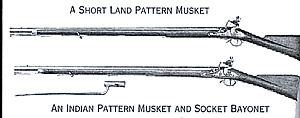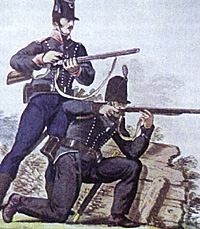Firearms: The Musket
 Throughout the 18th and early 19th centuries, the majority of infantrymen were armedwith the smoothbore flintlock musket. These muzzleloading weapons were relatively quick and easy to load, but the lack of rilfing and the poor fit of the ball in the barrel made them inherenently inaccurate over ranges of about 75 yards even in perfect conditions. As a result, in order to make the most effective use of their muskets, troops were trained to stand in line and fire their muskets enmasse in controlled volleys.
Throughout the 18th and early 19th centuries, the majority of infantrymen were armedwith the smoothbore flintlock musket. These muzzleloading weapons were relatively quick and easy to load, but the lack of rilfing and the poor fit of the ball in the barrel made them inherenently inaccurate over ranges of about 75 yards even in perfect conditions. As a result, in order to make the most effective use of their muskets, troops were trained to stand in line and fire their muskets enmasse in controlled volleys.
 At the beginning of the French Revolutionary Wars, the standard infantry weapon of the British was the Short Land Pattern Musket, or the "Brown Bess" which had been introducedinto service in 1763. The Short Land Pattern Musket weighed about 10.5 pounds, had a 42-inch long barrel with 0.78-inch bore and fired a ball of 14.5 to the pound. It was equipped with a socket bayonet with a 17-inch long triangular blade.
At the beginning of the French Revolutionary Wars, the standard infantry weapon of the British was the Short Land Pattern Musket, or the "Brown Bess" which had been introducedinto service in 1763. The Short Land Pattern Musket weighed about 10.5 pounds, had a 42-inch long barrel with 0.78-inch bore and fired a ball of 14.5 to the pound. It was equipped with a socket bayonet with a 17-inch long triangular blade.
The reserves of serviceable weapons were dreadfully low at the start of teh war with France and the Board of Ordnance was forced to look abroad for the purchase of weapons. However, the quality of foreign weapons proved so poor, the Board ordered large stocks of weapons then in use with the East Indies Company. Although not as good, these weapons proved sufficiently reliable and easy to manufacture that in 1797 they were adopted as the standard arm of the British Army.
The India Pattern Musket as it came to be known, weighed 9 pounds 11 ounces, had a 39-inch barrel, 0.75-inch bore and fired a ball of 16 to the pound. It was also equippedwith a socket bayonet.
When he joined the ranks of the 33rd Foot, Sharpe would have been issued a Short Land pattern musket. He carried this into Flanders and then to India. As some stage over the next nine years, he would have been issued a replacement musket, whicprobably would have been the India Pattern musket.
The Rifle
At the end of the 18th century, a new weapon appeared on the battlefiedls of Europe and North America -- the rifle. Although much slower to load than the musket, due to the tighter fit of the ball in the barrel, the rifle was far more accurate, especially in the hands of the highly skilled light infantrymen. In 1796, the Board of Ordnance decided to introduce the weapon into British service.
 After trials held at Woolwich in 1800, the Board decided to adopt the rifle designed by London gunsmith Ezekiel Baker. The Baker Rifle had a 30-inch bore with 7 rectangular grooves making a one quarter of a turn in the length of the barrel. The sights were a foresight brazed to the muzzle and a backsight set at 200 yards with an attachedfolding leaf sight set at 300 yards. The rifle was also equipped with a distinctive sword bayonet with a 23-inch single-edged blade 23 inches long.
After trials held at Woolwich in 1800, the Board decided to adopt the rifle designed by London gunsmith Ezekiel Baker. The Baker Rifle had a 30-inch bore with 7 rectangular grooves making a one quarter of a turn in the length of the barrel. The sights were a foresight brazed to the muzzle and a backsight set at 200 yards with an attachedfolding leaf sight set at 300 yards. The rifle was also equipped with a distinctive sword bayonet with a 23-inch single-edged blade 23 inches long.
The Baker Rifle was issued to the newly raised Experimental Rifle Corps (which became the 95th Regt or Rifle Brigade in 1803). It use was later extended to the 5/60th Regt. The early rifleswere a musket bore of 0.70 inches and fired a ball of 16 to the pound. However, these weapons and ammo were found to be too heavy by their troopsin the field, and so later rifles were made lighter by adopting a carbine bore of 0.625 inches and fired a ball of 20 to the pound.
Sharpe continued to use a longarm even after his commission, and when he transferred to the 95th, he adopted the Baker Rifle, which he carried through all his subsequent campaigns.
More Sharpe
-
Sharpe's Weapons: Introduction
Sharpe's Weapons: Richard Sharpe
Sharpe's Weapons: Firearms
Sharpe's Weapons: Swords
Back to Age of Napoleon No. 28 Table of Contents
Back to Age of Napoleon List of Issues
Back to MagWeb Master List of Magazines
© Copyright 1998 by Partizan Press.
This article appears in MagWeb (Magazine Web) on the Internet World Wide Web.
Other military history articles and gaming articles are available at http://www.magweb.com